Abstract
A systematic investigation of four heteroleptic bis(diimine) copper(I) dyes in n-type Dye-Sensitized Solar Cells (DSSCs) is presented. The dyes are assembled using a stepwise, on-surface assembly. The dyes contain a phosphonic acid-functionalized 2,2′-bipyridine (bpy) anchoring domain (5) and ancillary bpy ligands that bear peripheral phenyl (1), 4-methoxyphenyl (2), 3,5-dimethoxyphenyl (3), or 3,4,5-trimethoxyphenyl (4) substituents. In masked DSSCs, the best overall photoconversion efficiency was obtained with the dye [Cu(5)(4)]+ (1.96% versus 5.79% for N719). Values of JSC for both [Cu(5)(2)]+ (in which the 4-MeO group is electron releasing) and [Cu(5)(4)]+ (which combines electron-releasing and electron-withdrawing effects of the 4- and 3,5-substituents) and are enhanced with respect to [Cu(5)(1)]+. DSSCs with [Cu(5)(3)]+ show the lowest JSC. Solid-state absorption spectra and external quantum efficiency spectra reveal that [Cu(5)(4)]+ benefits from an extended spectral range at higher energies. Values of VOC are in the order [Cu(5)(4)]+ > [Cu(5)(1)]+ > [Cu(5)(2)]+ > [Cu(5)(3)]+. Density functional theory calculations suggest that methoxyphenyl character in MOs within the HOMO manifold in [Cu(5)(2)]+ and [Cu(5)(4)]+ may contribute to the enhanced performances of these dyes with respect to [Cu(5)(1)]+.
1. Introduction
Dye-sensitized solar cells (DSSCs) [1] convert solar to electrical energy using an optically transparent, wide-band gap semiconductor functionalized with a surface-bound dye which extends the absorption range into the visible spectrum [2,3,4]. The semiconductor is commonly mesoporous TiO2 and the sensitizer is typically a ruthenium(II) complex such as the standard reference dye N719 (Scheme 1) or an organic dye in DSSCs based on n-type semiconductors. Photoconversion efficiencies (η) of up to 11–14% have been recorded using ruthenium-based, organic, or zinc(II) porphyrin-based sensitizers [5,6,7,8,9,10]. However, the scarcity of ruthenium in the Earth’s crust and its associated high cost have motivated us and others to investigate the use of inorganic dyes containing Earth abundant metals. Copper(I) [11,12,13] and iron(II) [14,15] complexes are of primary interest. For copper-sensitized DSSCs, reported values of η in the range 3–5% [16,17,18] confirm the potential of DSSCs containing copper(I) dyes. When comparing these lower photoconversion efficiencies with the values obtained for state-of-the-art ruthenium(II) dyes, it is important to recognize that the dye structures and dye/electrolyte combinations in the ruthenium-based systems have been optimized for over a quarter of a century. In contrast, copper-based DSSCs are still in their infancy and, with systematic tuning of dye and electrolyte components [16,19,20,21,22] and the use of co-sensitization [18], enhanced performances are gradually being achieved.
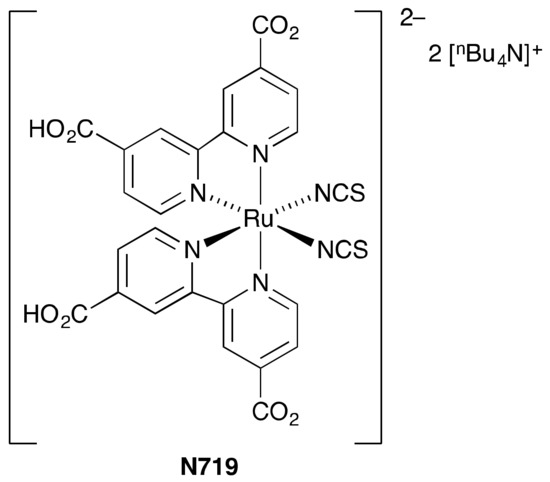
Scheme 1.
Structure of the ruthenium dye N719.
Most copper(I) sensitizers are bis(diimine) copper(I) complexes and “push–pull” dyes which facilitate electron injection necessarily require the use of heteroleptic complexes. To overcome the problems of rapid ligand redistribution in solution (Equation (1)), Odobel and coworkers have used the HETPHEN approach [17], in which sterically demanding groups in the 6,6′-positions of a 2,2′-bipyridine (bpy) or 2,9-positions in a 1,10-phenanthroline ligand stabilize the heteroleptic complex. Our own strategy is a “surfaces-as-ligands, surfaces as complexes” (SALSAC) approach in which the heteroleptic dye is assembled on the glass FTO/TiO2 electrode in a stepwise manner [11]. For performance enhancement, heteroleptic dyes are essential and the SALSAC approach remains the most adaptable. It also has an advantage of allowing dye regeneration [23,24].
For the anchoring domain in a dye in DSSCs, carboxylic acid (or carboxylate) anchors are commonly employed [25]. However, for heteroleptic copper(I) dyes, we have found that phosphonic acids are superior to carboxylic acids [11]. This is consistent with the strong binding of phosphonic acids and phosphonates to TiO2 [26] and the applications of phosphonic acid anchors in some ruthenium dyes [27].
We have investigated the use of ancillary ligands with hole-transporting dendrons [28], but such ligands are synthetically time-intensive, and we have generally found that dyes containing structurally simple ancillary ligands [16,18,29] perform as well, if not better, than those with more elaborate architecture. In accordance with the maxim “small is beautiful” [30], we now present an investigation of the effects on DSSC performance of introducing peripheral methoxy substituents into the ancillary ligand in bis(diimine) copper(I) dyes. The ancillary ligands 1–4 and anchoring ligand 5 (Scheme 2) each contain methyl substituents in the 6,6′-positions of the bpy unit to stabilize the copper(I) complexes. Copper(I) prefers a tetrahedral coordination geometry, and substituents close to the copper(I) centre prevent flattening to the square-planar geometry favoured by copper(II) [31]. The ancillary ligands 1, 2, 3, and 4 contain peripheral phenyl, 4-methoxyphenyl, 3,5-dimethoxyphenyl, and 3,4,5-trimethoxyphenyl substituents, respectively. We were interested to know how the overall electron-releasing behaviour of the para-OMe or electron-withdrawing nature of the meta-OMe substituents [32,33,34] would influence the DSSC performances of the dyes [Cu(5)(Lancillary)]+ (Lancillary = 1, 2, 3, or 4). Such substituent effects have been used by Wu et al. to tune properties of hole-transporting materials for perovskite solar cells [35].
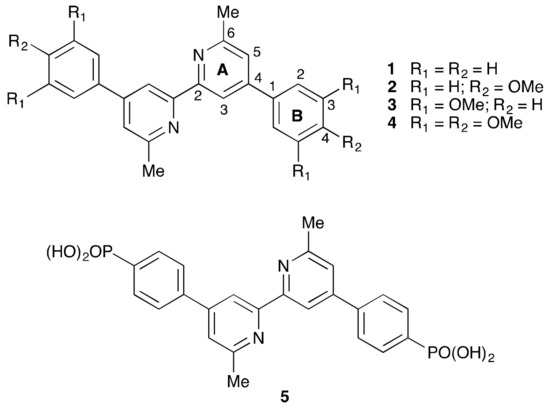
Scheme 2.
Structures of ligands and atom labelling for NMR assignments.
2. Results and Discussion
2.1. Synthesis and Compound Characterization
Compounds 1–3 and 5 were prepared as previously reported [36,37,38,39]. Ligand 4 was synthesized using Kröhnke [40] methodology as shown in Scheme 3. The 1H and 13C NMR spectra of 4 are displayed in Figures S1 and S2 and were assigned by COSY, NOESY, HMQC, and HMBC methods. A cross peak in the NOESY spectrum between HMe and HA5 distinguished the signals for HA3 and HA5. The methyl groups of the methoxy substituents give rise to 1H NMR resonances at δ 3.97 and 3.92 ppm (relative integrals of 2:1) while the signal assigned to the protons of the 6,6′-dimethyl groups appears at δ 2.72 ppm.

Scheme 3.
Synthesis of 4. Conditions: (i) piperidine, MeOH, reflux, overnight; (ii) NH4OAc, EtOH, reflux, overnight. Yields: 4a 13.0%; 4 23.1%.
The reaction of [Cu(MeCN)4][PF6] with ligands 1, 2, 3, or 4 yielded the orange-red homoleptic complexes [Cu(1)2][PF6], [Cu(2)2][PF6], [Cu(3)2][PF6], and [Cu(4)2][PF6], respectively. We have previously described [Cu(2)2][PF6], and the spectroscopic properties of the batch prepared in this study were fully in accord with the reported data [37]. Figures S3–S8 show 1H and 13C NMR spectra of [Cu(1)2][PF6], [Cu(3)2][PF6], and [Cu(4)2][PF6]. Figure 1 shows the 1H NMR spectrum of [Cu(4)2][PF6] as a representative example. The spectra were assigned by 2D methods. For [Cu(1)2][PF6], the 13C NMR signals for the phenyl ring C–H 13C nuclei appear in the range δ 130.9 to 128.4 ppm. On comparing [Cu(1)2][PF6] to [Cu(3)2][PF6], the signal for CB3 shifts to δ 162.6 ppm, consistent with the OMe groups attached to CB3. Signals for CB2 and CB4 appear at δ 106.7 and 102.2 ppm. In [Cu(4)2][PF6], nuclei CB3 and CB4 are characterized by 13C NMR signals at δ 154.2 and 139.9 ppm, respectively. In [Cu(4)2][PF6], the 13C NMR resonances for CA2 and CA6 could not be resolved in the 1D spectrum (Figure S8), and the HMBC spectrum was used to locate them at δ 157.4 and 152.1 ppm (Figure 2). In the respective electrospray mass spectrums of [Cu(1)2][PF6], [Cu(3)2][PF6], and [Cu(4)2][PF6], the base peak corresponded to the [M–PF6]+ ion at major isotopomer (m/z) = 735.24, 975.31, and 1095.30, respectively. Each peak envelope showed the predicted isotope pattern (Figure S9).
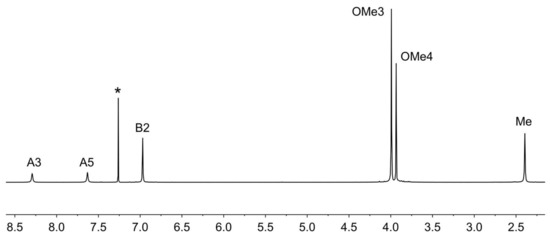
Figure 1.
The 500 MHz 1H NMR spectrum of [Cu(4)2][PF6] (CDCl3). * = residual CHCl3. Chemical shifts in δ/ppm. See Scheme 1 for labelling.
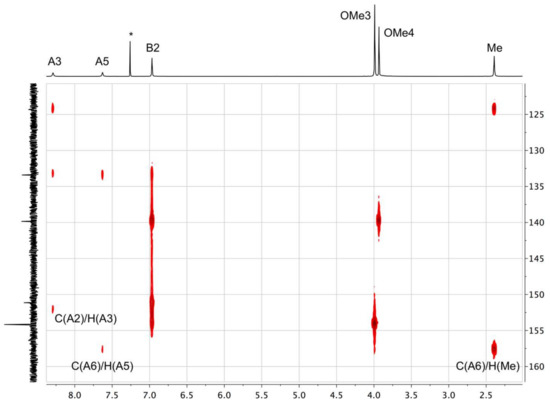
Figure 2.
Part of the HMBC spectrum (500 HMz 1H, 126 MHz 13C) of [Cu(4)2][PF6] (CDCl3). * = residual CHCl3.
2.2. Solution and Solid-State Absorption Spectra
The solution absorption spectra of the homoleptic complexes are presented in Figure 3 and the absorption maxima and intensity data are given in Table 1. We include the spectrum of [Cu(2)2][PF6] for comparison. The previously reported data was for an MeCN solution [37] whereas, here, the data is for CH2Cl2 solutions. Intense absorption bands below 390 nm arise from π*←π transitions in [Cu(1)2][PF6] and from π*←π and π*←n transitions in the compounds containing methoxy groups. Each compound exhibits a metal-to-ligand charge transfer (MLCT) band in the range 482–486 nm.
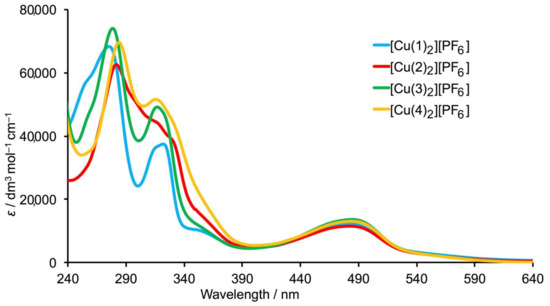
Figure 3.
Solution absorption spectra of the homoleptic copper(I) complexes (CH2Cl2, 1 × 10−5 mol dm−3).

Table 1.
Absorption maxima for homoleptic copper(I) complexes (CH2Cl2, 5 × 10−5 mol dm−3) a.
Heteroleptic dyes [Cu(5)(Lancillary)]+ were assembled on transparent TiO2 electrodes (i.e., no TiO2 scattering layer) by sequential dipping of the glass FTO/TiO2 electrodes in baths containing anchoring ligand 5 in DMSO (Scheme 2) and one of the homoleptic complexes in CH2Cl2 (Figure 4a). This process leads to the assembly of the surface-anchored heteroleptic dye, exemplified in Figure 4b by [Cu(5)(1)]+. The solid-state absorption spectra of the functionalized electrodes are shown in Figure 5, with the MLCT band appearing at 475 nm for [Cu(5)(1)]+ and [Cu(5)(2)]+, 476 nm for [Cu(5)(3)]+, and 473 nm for [Cu(5)(4)]+. A blue-shift of ca.10 nm is observed on going from the solution spectrum of [Cu(Lancillary)2]+ to the solid-state spectrum of the surface-bound [Cu(Lanchor)(Lancillary)]+ complex. The protonation state of the phosphonic acid is not known.
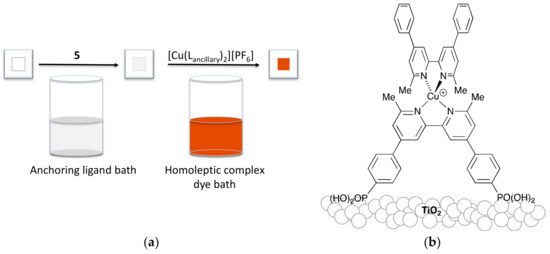
Figure 4.
(a) The SALSAC approach to functionalization of a glass FTO/TiO2 electrode surface with a heteroleptic [Cu(Lanchor)(Lancillary)]+ dye. Transparent electrodes were used for absorption spectroscopy, and TiO2 with a scattering layer was used for DSSC measurements. (b) Surface-anchored [Cu(5)(1)]+.
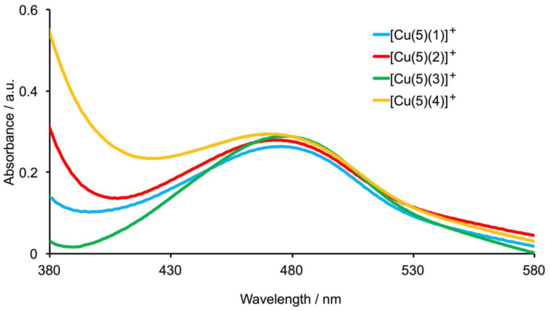
Figure 5.
Solid-state absorption spectra of FTO/TiO2 electrodes functionalized with [Cu(5)(Lancillary)]+ dyes (Lancillary = 1, 2, 3, or 4).
2.3. DSSC Performances
Working electrodes with a scattering layer were functionalized with the heteroleptic dyes [Cu(5)(Lancillary)]+ dyes (Lancillary = 1, 2, 3, or 4) as summarized in Figure 4, and duplicate masked DSSCs for each dye were assembled (see Materials and Methods). Reference DSSCs containing N719 (Scheme 1) were also fabricated (see Materials and Methods), and the plots of current density (J) against potential (V) in Figure 6 confirm the reproducibility of their performances. We have observed [16] that copper-dye functionalized DSSCs may improve in performance after initial fabrication. The J–V measurements for the DSSCs were, therefore, made on the day of sealing the cells (day 0) and repeated seven days later. The performance parameters for these masked DSSCs are given in Table 2. DSSCs with [Cu(5)(1)]+ and [Cu(5)(3)]+ were referenced to N719 cell 1, with [Cu(5)(2)]+ to N719 cell 2, and with [Cu(5)(4)]+ to N719 cell 3 (Table 2). The final column in Table 2 gives relative values of the efficiency η with respect to N719 set at 100%, and (on the day that the DSSCs were made) values range from 24.2% and 25.4% for [Cu(5)(3)]+ to 30.2% and 33.9% for [Cu(5)(4)]+. Comparisons of the DSSC parameters for days 0 and 7 indicate that the devices are stable over this period but that there are no ripening effects [41,42] leading to significantly enhanced performance.
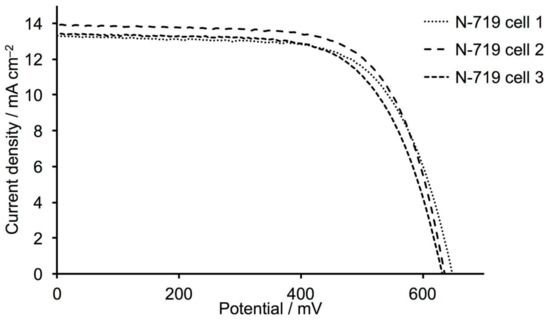
Figure 6.
J–V curves for three N719 reference cells (DSSCs were fully masked).

Table 2.
Performance parameters (under 1 sun illumination) of duplicate, masked DSSCs (mask aperture calibrated and ca. 0.06 cm2) with [Cu(5)(Lancillary)]+ (Lancillary = 1, 2, 3, or 4) on the day of sealing the cells, and after seven days. The data is compared to a DSSC containing N719 and relative η values are with respect to N719 set at 100% a.
Table 2 and the J–V curves in Figure 7 reveal that the highest short-circuit current densities (JSC) are obtained for the dyes [Cu(5)(2)]+ and [Cu(5)(4)]+ with the 4-MeO and 3,4,5-(MeO)3 substitution patterns in each phenyl ring (Scheme 2). While differences in JSC are small for these two dyes, values of the open-circuit voltages (VOC) are larger for [Cu(5)(4)]+ than [Cu(5)(2)]+. The replacement of the phenyl substituents in [Cu(5)(1)]+ by 4-methoxyphenyl or 3,4,5-trimethoxyphenyl groups in [Cu(5)(2)]+ and [Cu(5)(4)]+, respectively, enhances JSC but leads to a fall in VOC for [Cu(5)(2)]+, as opposed to a gain in VOC for [Cu(5)(4)]+. While Figure 7 shows this for the best performing cells, the scatter plots in Figure 8 confirm that the trend is true for the duplicate cells. The presence of the 4-MeO group is critical. The dye [Cu(5)(3)]+ containing 3,5-dimethoxyphenyl groups exhibits the lowest values of VOC and JSC of all four dyes (Figure 7 and Figure 8). The trends are consistent with the competitive mesomeric (+M) and inductive (−I) effects of the methoxy substituents. Electrons are released by the +M effect but are withdrawn by the −I effect. On going from 1 to 2, the electron-releasing 4-methoxy groups [32,33,34] enhance the “push–pull” characteristics of the dye, resulting in higher JSC. In contrast, introducing the electron-withdrawing 3,5-dimethoxy substituents [32,33,34] upon replacing ancillary ligand 1 by 3 has a detrimental effect on DSSC performance. Ancillary ligand 4 combines the effects of both ligands 2 and 3 and, interestingly, this results in the best-performing dye. DSSCs with [Cu(5)(4)]+ exhibit both the highest VOC and JSC (Figure 7 and Figure 8) and photoconversion efficiences up to 33.9% relative to N719 set at 100%. The trends in JSC are reflected in the external quantum efficiency (EQE) spectra displayed in Figure 9. Table 3 gives values of EQEmax and λmax, and values of λmax are similar to the absorption maxima in the solid-state spectra in Figure 5. The slightly lower EQEmax for [Cu(5)(4)]+ versus [Cu(5)(2)]+ is offset by the broader spectral range extending to higher energies; this is also observed in the solid-state absorption spectrum (Figure 5).
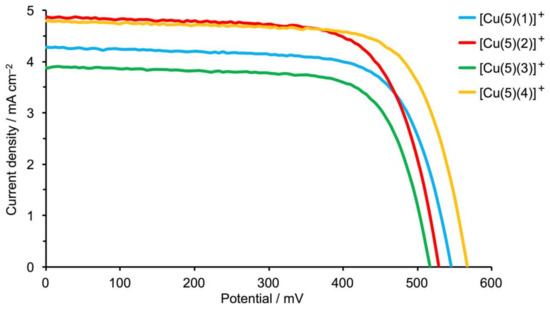
Figure 7.
J–V curves for the best performing DSSCs containing dyes [Cu(5)(Lancillary)]+ (Lancillary = 1–4).
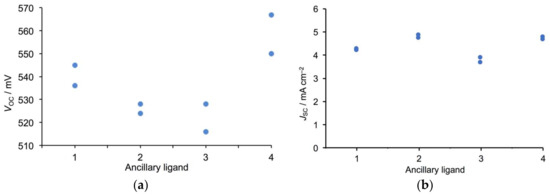
Figure 8.
Trends in values of (a) VOC and (b) JSC for duplicate DSSCs containing the dyes [Cu(5)(1)]+ (Ph groups), [Cu(5)(2)]+ (4-MeOC6H4 groups), [Cu(5)(3)]+ (3,5-(MeO)2C6H3 groups), or [Cu(5)(4)]+ (3,4,5-(MeO)3C6H2 groups).
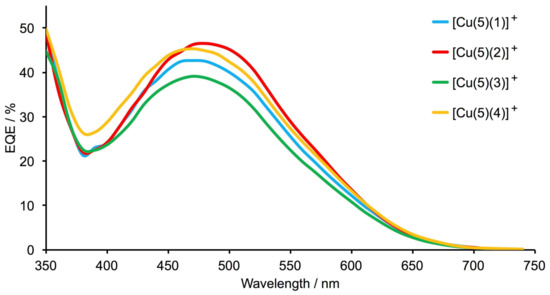
Figure 9.
EQE spectra for the best performing DSSCs containing dyes [Cu(5)(Lancillary)]+ (Lancillary = 1–4).

Table 3.
EQE maxima for duplicate DSSCs containing dyes [Cu(5)(Lancillary)]+ (Lancillary = 1–4).
2.4. Characteristics of the HOMO and LUMO Manifolds
Ground state density functional theory (DFT) calculations were used to examine how methoxy-substitution affects the characteristics of the molecular orbitals in the HOMO and LUMO manifolds of the dyes. In an earlier study of bis(diimine) copper(I) complexes, we demonstrated that use of different atomic orbital basis sets (6-311++G** basis set on all atoms, 6-311++G** on Cu, 6-31G* on C, H and N, or 6-31G* on all atoms) strongly influences the calculated absorption spectra but had no significant effect upon the characteristics of the MOs lying in the HOMO and LUMO manifolds [43]. In the present investigation, we therefore employed a 6-31G* basis set on all atoms to reduce the computational burden, and we focus mainly on orbital composition.
The characters of the MOs from HOMO−3 to LUMO+1 and energy levels are shown in Figure 10 and Figure 11. For all sensitizers, the LUMO is localized on the anchoring ligand while the LUMO+1 is localized on the bpy unit of the ancillary ligand. The energy gap between the LUMO and LUMO+1 is similar in each complex (Figure 11). Inspection of the character of the HOMO in each complex is instructive. The HOMO is essentially centered on copper. Although, in each of the methoxy-functionalized dyes there are additional contributions from the ancillary ligand extending over the peripheral aryl groups. This is most apparent for [Cu(5)(2)]+. The appearance of dominant methoxyphenyl character in HOMO−3 in [Cu(5)(2)]+ and [Cu(5)(4)]+, as well in HOMO−2 and HOMO−3 in [Cu(5)(3)]+, may aid hole transport over the ancillary ligand. This is reminiscent of [Cu(5)(7)]+ (7 = 4,4′-bis(4-iodophenyl)-6,6-dimethyl-2,2′-bipyridine), for which we have suggested that the improved performance of DSSCs containing [Cu(5)(7)]+ with respect to other halo-analogues may be associated with better electron transfer from the electrolyte over the 4-IC6H4 substituent [16].
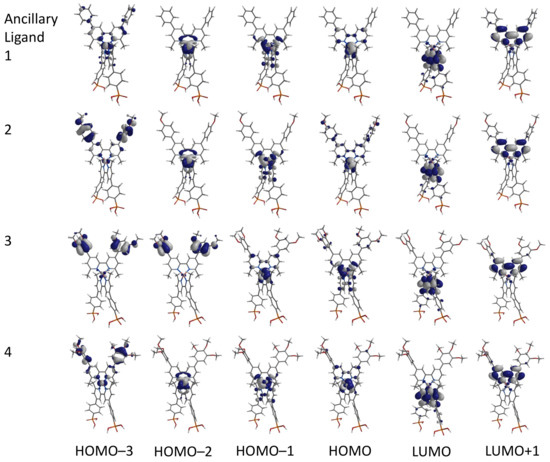
Figure 10.
Characteristics of the MOs from HOMO−3 to LUMO+1 of [Cu(5)(1)]+ (top row), [Cu(5)(2)]+, [Cu(5)(3)]+, and [Cu(5)(4)]+ (bottom row). The orientation of the complex is the same in each figure, with anchor 5 as the lower ligand. (DFT B3LYP level with a 6-31G* basis set in vacuum.).
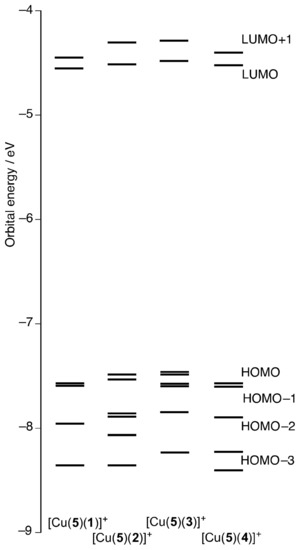
Figure 11.
Orbital energies carried at DFT B3LYP level with a 6-31G* basis set in vacuum for [Cu(5)(1)]+, [Cu(5)(2)]+, [Cu(5)(3)]+, and [Cu(5)(4)]+.
3. Materials and Methods
3.1. General
1H and 13C NMR spectra were recorded on a Bruker Avance III-500 NMR spectrometer (Bruker BioSpin AG, Fällanden, Switzerland), and 1H and 13C chemical shifts were referenced to residual solvent peaks with respect to δ(TMS) = 0 ppm. Solution and solid-state absorption spectra were recorded on a Cary 5000 spectrophotometer, (Agilent Technologies Inc., Santa Clara, CA, United States), respectively. Electrospray ionization (ESI) mass spectra were recorded on a Shimadzu LCMS-2020 instrument (Shimadzu Schweiz GmbH, Roemerstr, Switzerland), and high resolution ESI mass spectra were recorded on a Bruker maXis 4G QTOF instrument (Bruker Daltonics GmbH, Faellanden, Switzerland).
Compounds 1–3 and 5 were prepared as previously reported and spectroscopic data matching those reported [36,37,38,39] [Cu(MeCN)4][PF6] were prepared by the method in the literature [44], and [Cu(2)2][PF6] has previously been reported [37]. 3,4,5-Trimethoxybenzaldehyde was purchased from Sigma-Aldrich (Buchs, Switzerland).
3.2. Compound 4a
A suspension of 3,4,5-trimethoxybenzaldehyde (18.0 g, 89.9 mmol) and piperidine (0.897 mL, 8.99 mmol) in MeOH (150 mL) was heated to 50 °C and stirred until all solids had dissolved. A solution of 2,3-butanedione (3.97 mL, 45.0 mmol) in MeOH (30 mL) was added dropwise. The reaction mixture was heated to reflux for 4 h and slowly cooled to room temperature over 1 h. The precipitate that formed was separated by filtration and washed with Et2O. Compound 4a was isolated as an orange solid (3.65 g, 11.3 mmol, 13.0%). 1H NMR (500 MHz, CDCl3) δ/ppm 7.81 (d, J = 16.1 Hz, 2H, Halkene), 7.42 (d, J = 16.1 Hz, 2H, Halkene), 6.89 (s, 4H, HB2), 3.92 (s, 18 H, HOMe).
3.3. Compound 4
Compound 4a (858 mg, 1.94 mmol), 1-(2-oxopropyl)pyridinium chloride (666 mg, 3.88 mmol), and NH4OAc (4.49 g, 58.2 mmol) were dissolved in EtOH (100 mL) and heated to reflux overnight (~15 h). The solution was cooled to room temperature, and the precipitate that formed was separated by filtration and washed with Et2O. Ligand 4 was isolated as an orange solid (230 mg, 0.445 mmol, 23.1%). 1H NMR (500MHz, CDCl3) δ/ppm 8.40 (d, J = 1.7 Hz, 2H, HA3), 7.35 (d, J = 1.6 Hz, 2H, HA5), 6.93 (s, 4H, HB2), 3.97 (s, 12H, HOMe3), 3.92 (s, 6H, HOMe4), 2.72 (s, 6H, HMe). 13C NMR (126 MHz, CDCl3) δ/ppm 158.6 (CA6), 156.7 (CA2), 153.8 (CB3), 150.0 (CA4), 139.0 (CB4), 134.9 (CB1), 121.4 (CA5), 116.9 (CA3), 104.8 (CB2), 61.2 (COMe3), 56.8 (COMe4), 24.9 (CMe). ESI MS m/z 517.22 (calc. 517.23).
3.4. [Cu(1)2][PF6]
Ligand 1 (90.2 mg, 0.268 mmol) and [Cu(NCMe)4][PF6] (49.9 mg, 0.134 mmol) were dissolved in MeCN (25 mL) and stirred overnight at room temperature. The reaction mixture was then filtered, the solvent was removed under reduced pressure, and the resulting dark red solid was washed several times with Et2O to yield [Cu(1)2][PF6] as dark red solid (95 mg, 0.108 mmol, 80.4%). 1H NMR (500 MHz, CD3CN) δ/ppm 8.68 (s, 4H, HA3), 7.96 (d, J = 7.1 Hz, 8H, HB2), 7.85 (s, 4H, HA5), 7.60 (m, 12H, HB3+B4), 2.42 (s, 12H, HMe). 13C NMR (126 MHz, CD3CN) δ/ppm 158.8 (CA6), 153.3 (CA2), 151.2 (CA4), 138.1 (CB1), 130.9 (CB4), 130.3 (CB3), 128.4 (CB2), 124.6 (CA5), 118.8 (CA3), 25.5 (CMe). ESI MS m/z 735.24 [M − PF6]+ (calc. 735.25). HR ESI MS m/z 735.2542 [M − PF6]+ (calc. 735.2543).
3.5. [Cu(3)2][PF6]
[Cu(3)2][PF6] was prepared in the same manner as [Cu(1)2][PF6], starting with 3 (150 mg, 0.329 mmol) and [Cu(NCMe)4][PF6] (61.3 mg, 0.165 mmol) in MeCN (25 mL). [Cu(3)2][PF6] was isolated as a dark red solid (135 mg, 0.121 mmol, 73.2%). 1H NMR (500MHz, CD3CN) δ/ppm 8.68 (s, 4H, HA3), 7.83 (s, 4H, HA5), 7.08 (d, J = 2.0 Hz, 8H, HB2), 6.67 (s, 4H, HB4), 3.89 (s, 24H, HOMe), 2.34 (s, 12H, HMe). 13C NMR (126 MHz, CD3CN) δ/ppm 162.6 (CB3), 158.6 (CA6), 153.3 (CA2), 151.0 (CA4), 140.2 (CB1), 124.9 (CA5), 119.0 (CA3), 106.7 (CB2), 102.2 (CB4), 56.4 (COMe), 25.4 (CMe). ESI MS m/z 975.31 [M − PF6]+ (calc. 975.34). HR ESI MS m/z 975.3399 [M − PF6]+ (calc. 975.3389).
3.6. [Cu(4)2][PF6]
Ligand 4 (226 mg, 0.437 mmol) and [Cu(NCMe)4][PF6] (81.5 mg, 0.219 mmol) were dissolved in EtOH (25 mL) and the mixture was stirred for 4 h at room temperature. Water was added and the organic solvent removed under reduced pressure. The residue was filtered over Celite, washed with water and Et2O, and re-dissolved in MeCN. The solvent was removed under reduced pressure yielding [Cu(4)2][PF6] as a dark red solid (189 mg, 0.152 mmol, 69.5%). 1H NMR (500MHz, CDCl3) δ/ppm 8.29 (s, 4H, HA3), 7.63 (s, 4H, HA5), 6.97 (s, 8H, HB2+B6), 3.99 (s, 24H, HOMe3), 3.93 (s, 12H, HOMe4), 2.39 (s, 12H, HMe). 13C NMR (126 MHz, CDCl3) δ/ppm 157.4 (CA6), 154.2 (CB3), 152.1 (CA2), 151.1 (CA4), 139.9 (CB4), 133.4 (CB1), 124.3 (CA5), 117.7 (CA3), 105.0 (CB2), 61.2 (COMe4), 56.7 (COMe3), 25.5 (CMe). ESI MS m/z 1095.30 [M − PF6]+ (calc. 1095.38).
3.7. DSSC Fabrication
TiO2 electrodes (Solaronix Test Cell Titania Electrodes, Solaronix SA, Aubonne, Switzerland) were washed with milliQ water and HPLC grade EtOH, heated at 450 °C for 30 min, then cooled to ca. 80 °C. The thicknesses of the transparent and scattering layers were ~9 and 3 μm, respectively, by SEM [45]. The electrodes were then placed in a DMSO solution of 5 (1.0 mM) for 24 h at room temperature. The electrodes were removed from the solution, washed with DMSO and EtOH, and dried in an N2 stream. Each electrode was then immersed in a CH2Cl2 solution of [Cu(1)2][PF6], [Cu(2)2][PF6], [Cu(3)2][PF6], or [Cu(4)2][PF6] (0.1 mM) for 3 days at room temperature. After removal from the dye-bath, the electrodes were washed with CH2Cl2 and dried in an N2 stream. For N719 (Solaronix SA, Aubonne, Switzerland), TiO2 electrodes were soaked in a solution of N719 (EtOH, 0.3 mM) for 3 days. The electrodes were taken out of the dye-bath, washed with EtOH, and dried in an N2 stream. Commercial counter electrodes (Solaronix Test Cell Platinum Electrodes, Solaronix SA, Aubonne, Switzerland) were washed with EtOH and then heated at 450 °C for 30 min to remove volatile organics.
Thermoplast hot-melt sealing foil (Solaronix Test Cell Gaskets, 60 µm, Aubonne, Switzerland) was used to join the working and counter-electrodes. The space between the electrodes was filled with electrolyte (LiI (0.1 M), I2 (0.05 M), 1-methylbenzimidazole (0.5 M), 1-butyl-3-methylimidazolinium iodide (0.6 M) in 3-methoxypropionitrile) by vacuum backfilling through a hole in the counter electrode. Then, this hole was sealed (Solaronix Test Cell Sealings and Solaronix Test Cell Caps, Aubonne, Switzerland).
3.8. Electrodes for Solid-State Absorption Spectroscopy
Dye-functionalized electrodes were assembled using the immersion procedure above but using Solaronix Test Cell Titania Electrodes Transparent (Solaronix SA, Aubonne, Switzerland).
3.9. DSSC and External Quantum Efficiency (EQE) Measurements
The DSSCs were masked. The mask was made from a black-coloured copper sheet with an aperture (ca. 0.06 cm2, each mask accurately calibrated) smaller than the surface area of TiO2. Black tape was used to complete the top and side masking of each DSSC. Performance measurements were made by irradiating the DSSC from behind with a LOT Quantum Design LS0811 instrument (LOT-QuantumDesign GmbH, Darmstadt, Germany, 100 mW cm−2 = 1 sun, AM1.5 G conditions) and the simulated light power was calibrated with a silicon reference cell.
EQE measurements were made using a Spe Quest quantum efficiency setup (Rera Systems, Nijmegen, The Netherlands) operating with a 100 W halogen lamp (QTH) and a lambda 300 grating monochromator (L.O.T.-Oriel GmbH & Co. KG, Darmstadt, Germany). The monochromatic light was modulated to 3 Hz using a chopper wheel (ThorLabs Inc., Newton, NJ, USA), and the cell response was amplified with a large dynamic range IV converter (Melles Griot B.V., Didam, The Netherlands) and measured with a SR830 DSP Lock-In amplifier (Stanford Research Systems Inc., Sunnyvale, CA, USA).
3.10. DFT Calculations
Ground state density functional theory (DFT) calculations were carried out using Spartan 16 (v. 2.0.9) [46] at the B3LYP level with a 6-31G* basis set in vacuum. Initial energy optimization was carried out at a semi-empirical (PM3) level.
4. Conclusions
We have prepared and characterized the homoleptic copper(I) complexes [Cu(1)2][PF6], [Cu(3)2][PF6], and [Cu(4)2][PF6]. These and [Cu(2)2][PF6] have been used to assemble heteroleptic dyes on FTO/TiO2 electrodes utilizing the SALSAC approach with the bis(phosphonic acid) 5 as the anchoring ligand. In masked n-type DSSCs, the highest efficiency η was obtained for [Cu(5)(4)]+ (1.96% versus 5.79% for N719, or a relative efficiency of 33.9% with respect to N719). Although values of JSC are similar for DSSCs with [Cu(5)(2)]+ (electron releasing 4-MeO group in 2) and [Cu(5)(4)]+ (competitive electron-releasing and electron-withdrawing effects of 4-MeO and 3,5-(MeO)2 groups in 4), DSSCs with [Cu(5)(2)]+ exhibit a lower VOC than those with [Cu(5)(4)]+. DSSCs with [Cu(5)(3)]+ show the lowest JSC and VOC. Solid-state absorption spectra and EQE spectra demonstrate that [Cu(5)(4)]+ benefits from an extended spectral response at higher energies. Inspection of orbital characteristics from ground state DFT calculations demonstrates that orbital character in MOs within the HOMO manifold extends to the methoxyphenyl groups in [Cu(5)(2)]+ and [Cu(5)(4)]+, and we propose that this may contribute to the enhanced performances of these dyes with respect to [Cu(5)(1)]+.
Supplementary Materials
The following are available online at http://www.mdpi.com/2304-6740/6/2/40/s1, Figures S1–S8: NMR spectra of ligand 4 and complexes [Cu(1)2][PF6], [Cu(3)2][PF6] and [Cu(4)2][PF6]. Figure S9: ESI mass spectrum of [Cu(4)2][PF6].
Acknowledgments
We thank the Swiss National Science Foundation (Grant number 200020_162631) and the University of Basel for support. We thank Maximilian Klein (University of Basel) for preparing ligand 2, and Frederik J. Malzner (University of Basel) is acknowledged for assisting with Figure 4.
Author Contributions
Annika Büttner: Synthesis, compound characterization and DSSC measurements; Sven Y. Brauchli: synthesis and contributions to NMR spectroscopic data; Edwin C. Constable: project concepts and manuscript writing; Catherine E. Housecroft: project concepts and manuscript writing.
Conflicts of Interest
The authors declare no conflicts of interest.
References
- O’Reagan, B.; Grätzel, M. A low-cost, high-efficiency solar cell based on dye-sensitized colloidal TiO2 films. Nature 1991, 353, 737–740. [Google Scholar] [CrossRef]
- Nazeeruddin, M.K.; Baranoff, E.; Grätzel, M. Dye-sensitized solar cells. A brief overview. Sol. Energy 2011, 85, 1172–1178. [Google Scholar] [CrossRef]
- Grätzel, M. Recent Advances in Sensitized Mesoscopic Solar Cells. Acc. Chem. Res. 2009, 42, 1788–1798. [Google Scholar] [CrossRef] [PubMed]
- Grätzel, M. Solar Energy Conversion by Dye-Sensitized Photovoltaic Cells. Inorg. Chem. 2005, 44, 6841–6851. [Google Scholar] [CrossRef] [PubMed]
- Yella, A.; Lee, H.W.; Tsao, H.N.; Yi, C.; Chandiran, A.K.; Nazeeruddin, M.K.; Diau, E.W.; Yeh, C.Y.; Zakeeruddin, S.M.; Grätzel, M. Porphyrin-sensitized solar cells with cobalt (II/III)-based redox electrolyte exceed 12 percent efficiency. Science 2011, 334, 629–634. [Google Scholar] [CrossRef] [PubMed]
- Higashino, T.; Imahori, H. Porphyrins as excellent dyes for dye-sensitized solar cells: Recent developments and insights. Dalton Trans. 2015, 44, 448–463. [Google Scholar] [CrossRef] [PubMed]
- Xie, Y.; Tang, Y.; Wu, W.; Wang, Y.; Liu, J.; Li, X.; Tian, H.; Zhu, W.-H. Porphyrin Cosensitization for a Photovoltaic Efficiency of 11.5%: A Record for Non-Ruthenium Solar Cells Based on Iodine Electrolyte. J. Am. Chem. Soc. 2015, 137, 14055–14058. [Google Scholar] [CrossRef] [PubMed]
- Mathew, S.; Yella, A.; Gao, P.; Humphry-Baker, R.; Curchod, B.F.; Ashari-Astani, N.; Tavernelli, I.; Rothlisberger, U.; Nazeeruddin, M.K.; Grätzel, M. Dye-sensitized solar cells with 13% efficiency achieved through the molecular engineering of porphyrin sensitizers. Nat. Chem. 2014, 6, 242–247. [Google Scholar] [CrossRef] [PubMed]
- Kakiage, K.; Aoyama, Y.; Yano, T.; Oya, K.; Fujisawa, J.-I.; Hanaya, M. Highly-efficient dye-sensitized solar cells with collaborative sensitization by silyl-anchor and carboxy-anchor dyes. Chem. Commun. 2015, 51, 15894–15897. [Google Scholar] [CrossRef] [PubMed]
- Kakiage, K.; Aoyama, Y.; Yano, T.; Oya, K.; Kyomen, T.; Hanaya, M. Fabrication of a high-performance dye-sensitized solar cell with 12.8% conversion efficiency using organic silyl-anchor dyes. Chem. Commun. 2015, 51, 6315–6317. [Google Scholar] [CrossRef] [PubMed]
- Housecroft, C.E.; Constable, C.E. The Emergence of copper(I)-based dye sensitized solar cells. Chem. Soc. Rev. 2015, 44, 8386–8398. [Google Scholar] [CrossRef] [PubMed]
- Magni, M.; Biagini, P.; Colombo, A.; Dragonetti, C.; Roberto, D.; Valore, A. Versatile copper complexes as a convenient springboard for both dyes and redox mediators in dyes sensiatized solar cells. Coord. Chem. Rev. 2016, 322, 69–93. [Google Scholar] [CrossRef]
- Sandroni, M.; Pellegron, Y.; Odobel, F. Heteroleptic bis-diimine copper(I) complexes for applications in solar energy conversion. Compt. Rendus Chim. 2016, 19, 79–93. [Google Scholar] [CrossRef]
- Jakubikova, E.; Bowman, D.N. Fe(II)-Polypyridines as Chromophores in Dye-Sensitized Solar Cells: A Computational Perspective. Acc. Chem. Res. 2015, 48, 1441–1449. [Google Scholar] [CrossRef] [PubMed]
- Liu, Y.; Persson, P.; Sundström, V.; Wärnmark, K. Fe N-Heterocyclic Carbene Complexes as Promising Photosensitizers. Acc. Chem. Res. 2016, 49, 1477–1485. [Google Scholar] [CrossRef] [PubMed]
- Malzner, F.J.; Brauchli, S.Y.; Constable, E.C.; Housecroft, C.E.; Neuburger, M. Halos show the path to perfection: peripheral iodo-substituents improve the efficiencies of bis(diimine)copper(I) dyes in dye-sensitized solar cells. RSC Adv. 2014, 4, 48712–48723. [Google Scholar] [CrossRef]
- Sandroni, M.; Favereau, L.; Planchat, A.; Akdas-Kilig, H.; Szuwarski, N.; Pellegrin, Y.; Blart, E.; Le Bozec, H.; Boujtita, M.; Odobel, F. Heteroleptic copper(I)–polypyridine complexes as efficient sensitizers for dye sensitized solar cells. J. Mater. Chem. A 2014, 2, 9944–9947. [Google Scholar] [CrossRef]
- Malzner, F.J.; Willgert, M.; Constable, E.C.; Housecroft, C.E. The way to panchromatic copper(I)-based dye-sensitized solar cells: Co-sensitization with the organic dye SQ2. J. Mater. Chem. A 2017, 5, 13717–13729. [Google Scholar] [CrossRef]
- Fürer, S.O.; Bozic-Weber, B.; Schefer, T.; Wobill, C.; Constable, E.C.; Housecroft, C.E.; Willgert, M. Understanding why replacing I3−/I− by cobalt(II)/(III) electrolytes in bis(diimine)copper(I)-based dye-sensitized solar cells improves performance. J. Mater. Chem. A 2016, 4, 12995–13004. [Google Scholar] [CrossRef]
- Ashbrook, L.N.; Elliott, C.M. Dye-Sensitized Solar Cell Studies of a Donor-Appended Bis(2,9-dimethyl-1,10-phenanthroline) Cu(I) Dye Paired with a Cobalt-Based Mediator. J. Phys. Chem. C 2013, 117, 3853–3864. [Google Scholar] [CrossRef]
- Fürer, S.O.; Luu, L.Y.N.; Bozic-Weber, B.; Constable, E.C.; Housecroft, C.E. Improving performance of copper(I)-based dye sensitized solar cells through I3−/I− electrolyte manipulation. Dyes Pigment. 2016, 132, 72–78. [Google Scholar] [CrossRef]
- Dragonetti, C.; Magni, M.; Colombo, A.; Melchiorre, F.; Biagini, P.; Roberto, D. Coupling of a Copper Dyes with a Copper Electrolyte: A Fascinating Springboard for Sustainable Dye-Sensitized Solar Cells. ACS Appl. Energy Mater. 2018, 1, 751–756. [Google Scholar] [CrossRef]
- Büttner, A.; Brauchli, S.Y.; Vogt, R.; Constable, E.C.; Housecroft, C.E. Combining phosphonic acid-functionalized anchoring ligands with asymmetric ancillary ligands in bis(diimine)copper(I) dyes for dye-sensitized solar cells. RSC Adv. 2016, 6, 5205–5213. [Google Scholar] [CrossRef]
- Brauchli, S.Y.; Malzner, F.J.; Constable, E.C.; Housecroft, C.E. Copper(I)-based dye-sensitized solar cells with sterically demanding anchoring ligands: Bigger is not always better. RSC Adv. 2015, 5, 48516–48525. [Google Scholar] [CrossRef]
- Zhang, L.; Cole, J.M. Anchoring Groups for Dye-sensitized Solar Cells. ACS Appl. Mater. Interfaces 2015, 7, 3427–3455. [Google Scholar] [CrossRef] [PubMed]
- Vioux, A.; Le Bideau, J.; Mutin, P.H.; Leclercq, D. Hybrid Organic–Inorganic Materials Based on organophosphorus Derivatives. Top. Curr. Chem. 2004, 232, 145–174. [Google Scholar] [CrossRef]
- Wang, P.; Klein, C.; Moser, J.-E.; Humphry-Baker, R.; Cevey-Ha, N.-L.; Charvet, R.; Comte, P.; Zakeeruddin, S.M.; Grätzel, M. Amphiphilic Ruthenium Sensitizer with 4,4′-Diphosphonic Acid-2,2′-bipyridine as Anchoring Ligand for Nanocrystalline Dye Sensitized Solar Cells. J. Phys. Chem. B 2004, 108, 17553–17559. [Google Scholar] [CrossRef]
- Bozic-Weber, B.; Brauchli, S.Y.; Constable, E.C.; Fürer, S.O.; Housecroft, C.E.; Wright, I.A. Hole-transport functionalized copper(I) dye sensitized solar cells. Phys. Chem. Chem. Phys. 2013, 15, 4500–4504. [Google Scholar] [CrossRef] [PubMed]
- Malzner, F.J.; Prescimone, A.; Constable, E.C.; Housecroft, C.E.; Willgert, M. Exploring simple ancillary ligands in copper-based dye-sensitized solar cells: Effects of a heteroatom switch and of co-sensitization. J. Mater. Chem. A 2017, 5, 4671–4685. [Google Scholar] [CrossRef]
- Schumacher, E.F. Small Is Beautiful: A Study of Economics as if People Mattered; Blond & Briggs Ltd.: London, UK, 1973. [Google Scholar]
- Eggleston, M.K.; McMillin, D.R.; Koenig, K.S.; Pallenberg, A.J. Steric Effects in the Ground and Excited States of Cu(NN)2+ Systems. Inorg. Chem. 1997, 36, 172–176. [Google Scholar] [CrossRef]
- Hammett, L.P. The Effect of Structure upon the Reactions of Organic Compounds. Benzene Derivatives. J. Am. Chem. Soc. 1937, 59, 96–103. [Google Scholar] [CrossRef]
- McDaniel, D.H.; Brown, H.C. An Extended Table of Hammett Substituent Constants Based on the Ionization of Substituted Benzoic acids. J. Org. Chem. 1958, 23, 420–427. [Google Scholar] [CrossRef]
- Hansch, C.; Leo, A.; Taft, R.W. A Survey of Hammett Substituent Constants and Resonance and Field Parameters. Chem. Rev. 1991, 91, 165–195. [Google Scholar] [CrossRef]
- Wu, F.; Liu, J.; Wang, G.; Song, Q.; Zhu, L. m-Methoxy Substituents in a Tetraphenylethylene-Based Hole-Transport Material for Efficient Perovskite Solar Cells. Chem. Eur. J. 2016, 22, 16636–16641. [Google Scholar] [CrossRef] [PubMed]
- Mukkala, V.M.; Kankare, J.J. New 2,2′-Bipyridine Derivatives and Their Luminescence Properties with Europium(III) and Terbium(III) Ions. Helv. Chim. Acta 1992, 75, 1578–1592. [Google Scholar] [CrossRef]
- Constable, E.C.; Housecroft, C.E.; Neuburger, M.; Poleschak, I.; Zehnder, M. Functionalised 2,2′-bipyridine ligands for the preparation of metallostars; X-ray structures of free ligands and preparation of copper(I) and silver(I) complexes. Polyhedron 2003, 22, 93–108. [Google Scholar] [CrossRef]
- Boudebous, A.; Constable, E.C.; Housecroft, C.E.; Neuburger, M.; Schaffner, S.; Listorti, A.; Sabatini, C.; Barigelletti, F. Preparation and photophysical studies of copper(I) and ruthenium(II) complexes of 4,4′-bis(3,5-dimethoxyphenyl)-6,6′-dimethyl-2,2′-bipyridine. Inorg. Chim. Acta 2009, 362, 1825–1830. [Google Scholar] [CrossRef]
- Bozic-Weber, B.; Brauchli, S.Y.; Constable, E.C.; Fürer, S.O.; Housecroft, C.E.; Malzner, F.J.; Wright, I.A.; Zampese, J.A. Improving the photoresponse of copper(I) dyes in dye-sensitized solar cells by tuning ancillary and anchoring ligand modules. Dalton Trans. 2013, 42, 12293–12308. [Google Scholar] [CrossRef] [PubMed]
- Kröhnke, F. The Specific Synthesis of Pyridines and Oligopyridines. Synthesis 1976. [Google Scholar] [CrossRef]
- Wenger, B.; Grätzel, M.; Moser, J.-E. Rationale for Kinetic Heterogeneity of Ultrafast Light-Induced Electron Transfer from Ru(II) Complex Sensitizers to Nanocrystalline TiO2. J. Am. Chem. Soc. 2005, 127, 12150–12151. [Google Scholar] [CrossRef] [PubMed]
- Thorsmølle, V.K.; Wenger, B.; Teuscher, J.; Bauer, C.; Moser, J.-E. Dynamics of Photoinduced Interfacial Electron Transfer and Charge Transport in Dye-Sensitized Mesoscopic Semiconductors. CHIMIA Int. J. Chem. 2007, 61, 631–634. [Google Scholar] [CrossRef][Green Version]
- Bozic-Weber, B.; Chaurin, V.; Constable, E.C.; Housecroft, C.E.; Meuwly, M.; Neuburger, M.; Rudd, J.A.; Schönhofer, E.; Siegfried, L. Exploring copper(I)-based dye-sensitized solar cells: A complementary experimental and TD-DFT investigation. Dalton Trans. 2012, 41, 14157–14169. [Google Scholar] [CrossRef] [PubMed]
- Kubas, G.J. Tetrakis(Acetonitrile)Copper(I) Hexafluorophosphate. Inorg. Synth. 1979, 19, 90–92. [Google Scholar] [CrossRef]
- Brauchli, S.Y.; Bozic-Weber, B.; Constable, E.C.; Hostettler, N.; Housecroft, C.E.; Zampese, J.A. Factors controlling the photoresponse of copper(I) diimine dyes containing hole-transporting dendrons in dye-sensitized solar cells. RSC Adv. 2014, 4, 34801–34815. [Google Scholar] [CrossRef]
- Spartan′16; Wavefunction Inc.: Irvine, CA, USA, 2017.
© 2018 by the authors. Licensee MDPI, Basel, Switzerland. This article is an open access article distributed under the terms and conditions of the Creative Commons Attribution (CC BY) license (http://creativecommons.org/licenses/by/4.0/).